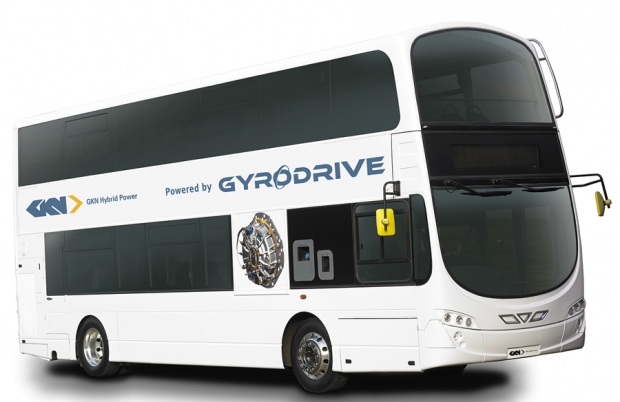GKN Land Systems is ramping up production of a new hybrid technology for buses that will enable operators to save fuel, reduce fares and make some routes more viable. Demand for the company’s Gyrodrive electric flywheel hybrid is growing following successful trials in London and the start of UK production.
GKN Hybrid Power’s Gyrodrive electric flywheel technology is a Kinetic Energy Recovery System (KERS). When a vehicle brakes, it harvests the energy normally lost as heat. The flywheel stores the energy and returns it to the wheels on demand, boosting power, saving fuel and reducing emissions. When the driver brakes, a traction motor on one of the axles slows the vehicle, generating electricity at the same time. This electricity is used to charge the flywheel, spinning it at up to 36,000rpm. When the driver accelerates, the system works in reverse. The energy is drawn from the flywheel and converted back into electricity to power the traction motor. This reduces the work done by the internal combustion engine, improving fuel economy by up to 25%, depending on the application.
GKN Land Systems CEO Phil Swash said: “Gyrodrive is the first hybrid technology that makes economic sense for bus operators. Gyrodrive is part of GKN’s strategy to offer customers new hybrid and electric driveline solutions that compliment our existing portfolio of technologies. In the next five years hybrid and electric systems will become increasingly more important to commercial, off-highway and agricultural vehicles. As we increase production volumes, GKN’s economies of scale will make Gyrodrive’s cost and benefits compelling for many commercial vehicle operators.”
The Gyrodrive system is a lower cost alternative to conventional battery hybrids. The upfront investment is a fraction of the cost of existing hybrids. With real-world fuel savings of up to 25%, the payback period for bus operators is three to four years. The system is smaller than conventional battery or super-capacitor hybrid units, which means it does not compromise seating or passenger capacity and can be retro-fitted to existing fleets.
The electric flywheel started life in motorsport. In June, GKN’s Gyrodrive system helped power Audi Motorsport’s hybrid race car to a third consecutive victory in the gruelling Le Mans 24 Hour endurance race.
“Bus operators want certainty on the fuel and cost savings and the reliability,” said Jules Carter. “Buses are the perfect first step for Gyrodrive as GKN builds production volumes,” said Carter. “Extensive trials in London proved the technology offers operators certainty on the savings and the reliability. With buses an important part of transport policies in the developing world’s fast-growing megacities, Gyrodrive has the potential to play a global role in improving city air quality.”
Gyrodrive will also help improve the efficiency of other commercial vehicles used in cities. Refuse and delivery truck applications are planned, so are agriculture and construction vehicles. Heavy vehicles with ‘stop-and-go’ or ‘back-and-forth’ duty cycles consume a lot of energy that Gyrodrive can recover and regenerate. In the longer term, as volumes increase and costs reduce, GKN expects Gyrodrive to be a viable option for mass-production vehicles.


